An analysis of 100 local authorities shows that employer contribution rates are likely to remain stable following the 2022 LGPS valuations. Fund actuary Robbie McInroy examines the results and trends.
It is perhaps a sign of the uncertain times we are in today that many LGPS stakeholders are unsure of what to expect from the 2022 valuations. The headlines so far are strong past service funding positions but an increasing cost of paying for new benefits (primary rates). To help complete the picture, we analysed the provisional employer contribution results for the first 100 local authorities from LGPS funds advised by Hymans Robertson.
A lot has changed in the world since the 2019 valuation, yet the LGPS continues to prove its resilience. Despite turbulent times, LGPS investment returns have been positive since 2019 and funds are expecting to report strong past service funding positions.
However, today’s more uncertain economic outlook is putting upward pressure on the expected cost of paying for new benefits. The impact of short-term inflationary pressures and long-term expected investment returns are chiefly to blame, but on top of this we have the uncertainty around climate risk, post-pandemic life expectancy, political policy and escalating geopolitical tensions. This uncertainty flows through to not knowing what will happen to employer contribution rates at the 2022 valuations.
Removing some of the uncertainty
For long-term secure employers like councils, we were able to cut through some of the shorter-term “noise” and use modelling and analysis to gain better insight and perspective. This means setting funding plans that aren’t beholden to market conditions as at end March, supporting the priority of keeping contributions sustainable and stable over time.
The additional advantage for many funds is that we have already started progressing contribution analysis and discussions over the last six months. This allows us to share the provisional results from around 100 councils across England and Wales from the funds advised by Hymans Robertson.
This early data represents around 30% of all English and Welsh councils and provides a solid cross-section of location, size, funding levels and current contributions in payment to look at the emerging trends.
It’s a reasonably balanced picture with nearly half the councils and funds agreeing to keep contributions at current levels or within a 1% of pay change over the cycle.
Overall picture
The below chart indicates what proportion of councils have provisionally agreed to increase or reduce rates, split by magnitude of the changes over the 2022 contribution rate cycle (2023 to 2026). For example, for reductions under 3% (far left blue bar), around 11% of councils will see a decrease of more than 3% of pay over the cycle.
Overall, it’s a reasonably balanced picture with nearly half the councils and funds agreeing to keep contributions at current levels or within a 1% of pay change over the cycle. In fact, over 85% of councils are not increasing or decreasing contributions by more than 3% of pay over the next three years (equivalent to 1% of pay per annum).
This means the priority of stable contributions over time looks like it’s being achieved from this early provisional data.
Looking across the spectrum
We’ve also considered the same chart but this time looking at only those councils currently paying less than 20% of pay. Our research shows that no contribution reductions have been considered for this group. This is unsurprising given the upward pressure on the primary rate. However, stability is still broadly being delivered with over 90% of councils not changing contributions by more than 1% of pay per annum.
Another key observation is that all the councils with increases of more than 3%, over a 3-year period, belong to this group of councils currently paying relatively lower contributions.
However, if we consider the other end of the spectrum – councils paying more than 30% of pay – we see a different story.
Our data shows that this higher-contribution group includes the majority of councils where larger reductions are being implemented.
Avoiding surprises
With increased uncertainty, more options, growing diversity and differing stakeholder views, early engagement with councils has helped avoid surprises and time-pressured conversations later in the year.
So far, the news is good – stability of contributions is being delivered for most local authorities. Those currently paying higher than average contributions will have benefited the most from strong returns and improved funding positions and may see the “best news” in terms of rate changes over the next few years. If funding positions continue to remain strong, we would expect to see local authority rates start to converge as past service positions matter less and the ongoing cost of new benefits – which is similar for everyone – becomes the dominant factor in determining contributions.
Robbie McInroy is a partner and fund actuary at Hymans Robertson.
—————
FREE weekly newsletters
Subscribe to Room151 Newsletters
Room151 LinkedIn Community
Join here
Monthly Online Treasury Briefing
Sign up here with a .gov.uk email address
Room151 Webinars
Visit the Room151 channel

















